Each week we produce a chart book of the major financial markets to review whether the markets, as a whole, warrant higher levels of equity risk in portfolios or not. Stocks, as a whole, tend to rise and fall with the overall market. Therefore, if we get the short-term trend of the market right, our portfolios should perform respectively.
HOW TO READ THE CHARTS
There are three primary components to each chart:
- The price chart is in orange
- The Over Bought/Over Sold indicator is in gray
- The Buy / Sell indicator is in blue.
When the gray indicator is at the TOP of the chart, there is typically more risk and less reward available at the current time. In other words, the best time to BUY is when the short-term condition is over-sold. Likewise when the buy/sell indicator is above the ZERO line investments have a tendency of working better than when below the zero line.
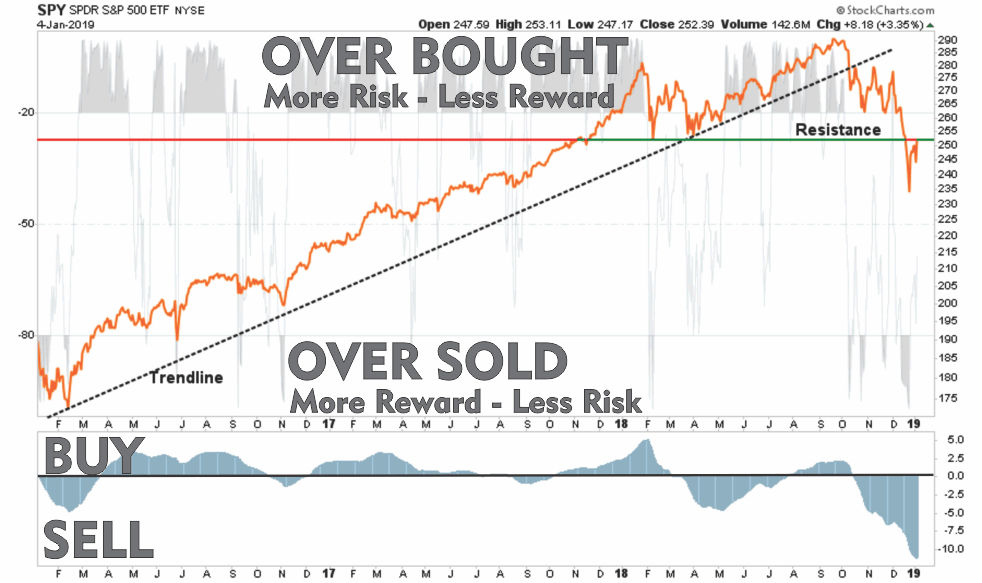
With this basic tutorial let’s review the major markets.
S&P 500 Index
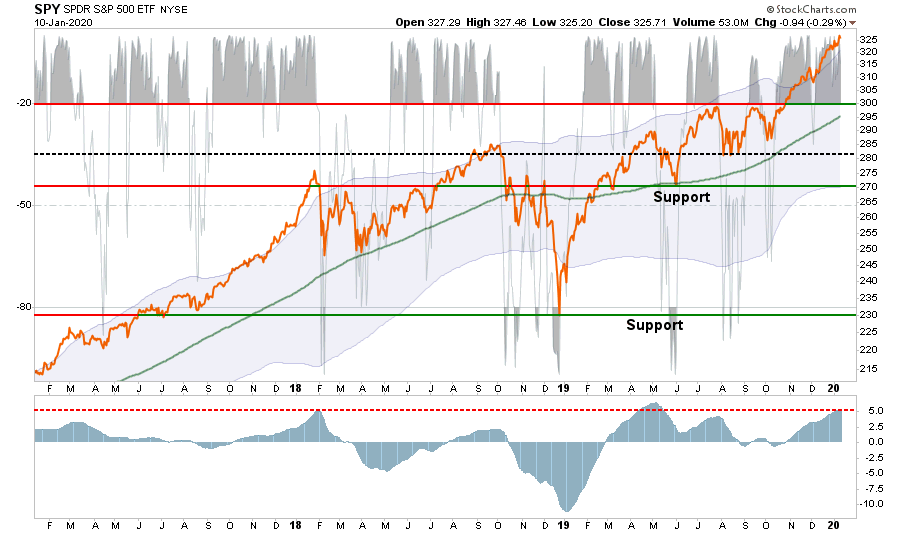
- On Friday, the market had a small drop after we took profits in our portfolios. However, that drop did little to resolve any of the overbought conditions which currently exisit.
- The S&P remains more than 2-standard deviations above the 200-dma (shaded blue area).
- The “buy signal” (lower panel) is back to levels of extensions normally only seen with short-term tops and corrective actions, particularly when combined with extreme extensions and deviations from long-term means.
- As noted we took profits in both the ETF and Equity Model (See Portfolio Commentary) and we still recommend taking profits and rebalancing risks in positions accordingly. We will likely have a much better entry point in the next couple of months to buy into.
- Short-Term Positioning: Neutral Due To Extension
- Last Week: Hold position
- This Week: Take profits and rebalance to target weights.
- Stop-loss moved up to $300
- Long-Term Positioning: Neutral due to valuations
Dow Jones Industrial Average
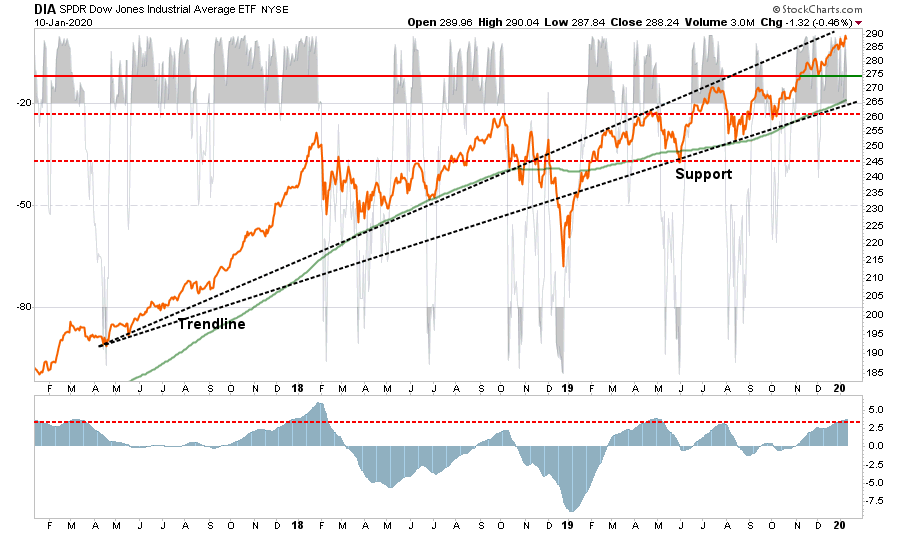
- As goes the S&P 500, goes the DIA, especially when MSFT & AAPL are the two top holdings and drivers of the advance in both markets. (We reduced both of those holdings last week.)
- The “buy” signal is extremely extended along with a very overbought condition.
- Hold current positions and take profits, but as with SPY, wait for a correction before adding further exposure.
- Short-Term Positioning: Neutral due to extensions
- Last Week: Hold current positions
- This Week: Take profits and rebalance risk.
- Stop-loss moved up to $275
- Long-Term Positioning: Neutral
Nasdaq Composite
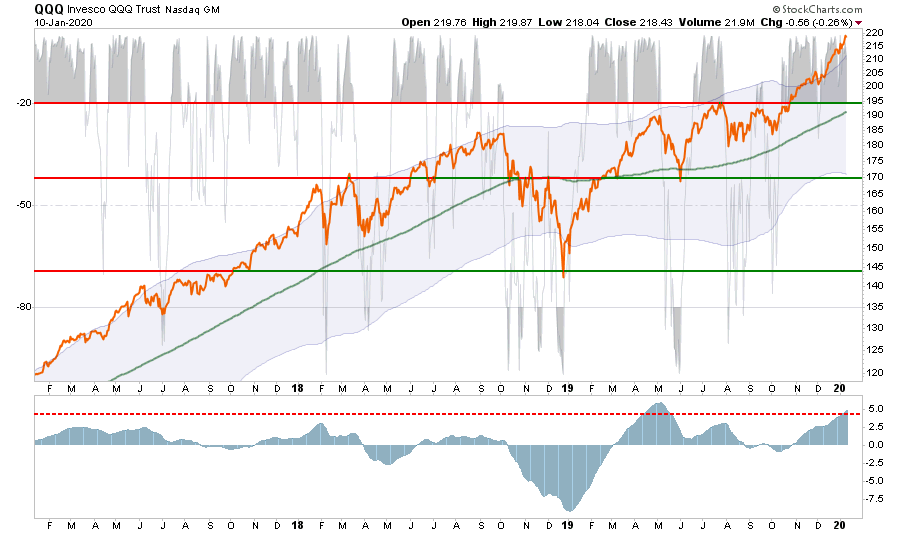
- Again, like SPY, the Nasdaq is just “crazy” extended currently. With QQQ now pushing the limits of 3-standard deviations, a correction is inevitable, it is just a function of time now.
- The Nasdaq “buy signal” is also back to extremely overbought levels so look for a correction to add exposure.
- Short-Term Positioning: Neutral due to extensions.
- Last Week: Hold position
- This Week: Take profits and rebalance risks.
- Stop-loss moved up to $195
- Long-Term Positioning: Neutral due to valuations
S&P 600 Index (Small-Cap)
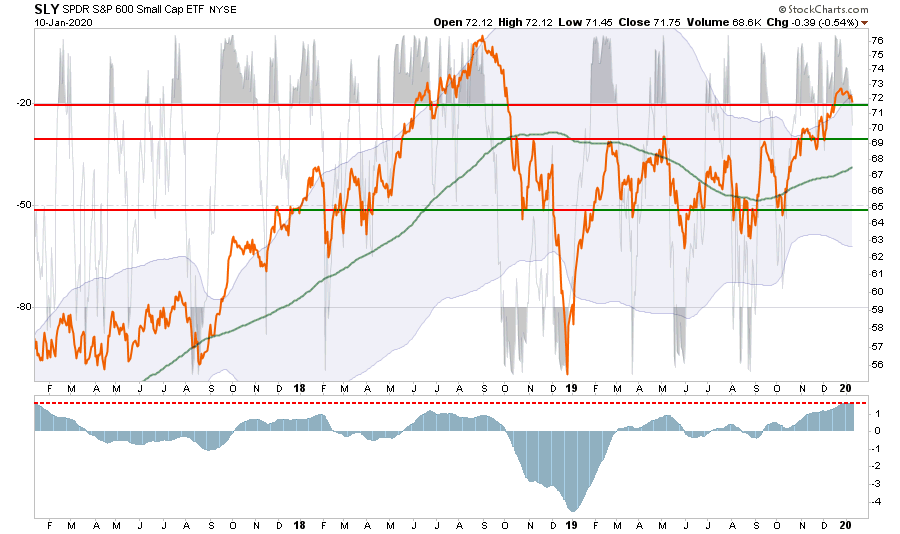
- As noted above, small-caps have also pushed above 2-standard deviations of the 200-dma.
- With the buy signal also extremely extended, and the index overbought, like all the other markets, a correction will provide a better entry point to add to our positions.
- That correction has started and the current support level is being tested. A failure here and the previous breakout levels will be the next important support and our stop level.
- Short-Term Positioning: Neutral due to extensions.
- Last Week: Hold positions
- This Week: Hold positions
- Stop loss moved up to $69
- Long-Term Positioning: Neutral
S&P 400 Index (Mid-Cap)
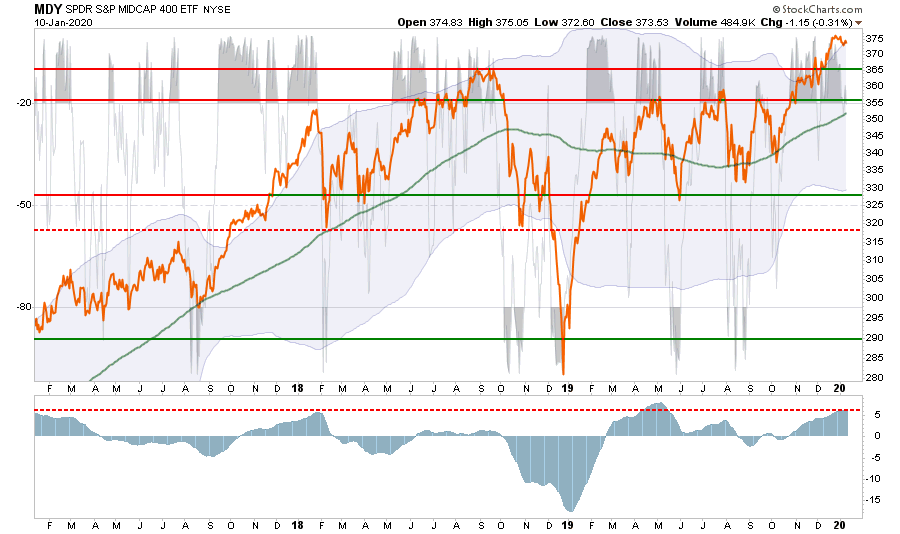
- Like SLY, MDY is also extremely extended and deviated above the 200-dma, and it has started to correct a bit finally.
- With MDY’s “buy” signal extremely extended, and very overbought, this is a prime setup for a correction. Hold off adding exposure until we see a better entry point.
- Short-Term Positioning: Neutral due to extensions.
- Last Week: No holding
- This Week: No holding
- Long-Term Positioning: Bullish
Emerging Markets
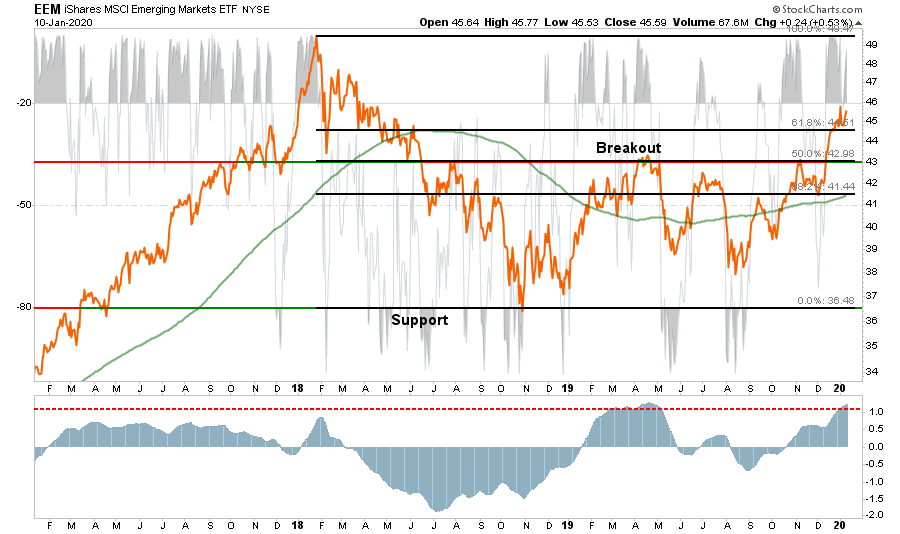
- EEM continues to underperform but did finally breakout above resistance. The next target will be the old highs.
- With the “buy signal” extremely extended, the set up to add exposure is not present. Be patient for a correction that does not violate our stop.
- EEM has tested, and held the 61.8% Fibonacci retracement level, so if it can break above the recent high, that will continue the bullish trend.
- The Dollar (Last chart) is the key to our international positioning. The dollar looks to have confirmed a break lower which should support our thesis of adding back international exposure.
- Short-Term Positioning: Neutral
- Last Week: Hold positions
- This Week: Hold positions
- Stop-loss set at $43
- Long-Term Positioning: Neutral
International Markets
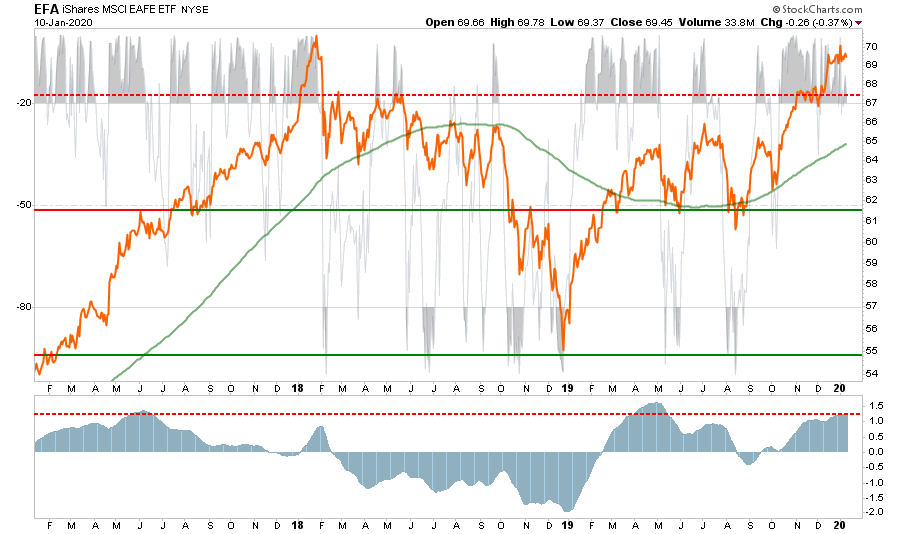
- Like EEM, EFA rallied out of its consolidation channel and broke out.
- But, like EEM, the market is both EXTREMELY overbought and extended. Also, EFA is testing old highs which, as previously expected, is providing short-term resistance.
- As with EEM, the key to our positioning is the US Dollar.
- Short-Term Positioning: Neutral
- Last Week: Hold positions
- This Week: Hold positions
- Stop-loss set at $67
- Long-Term Positioning: Neutral
West Texas Intermediate Crude (Oil)
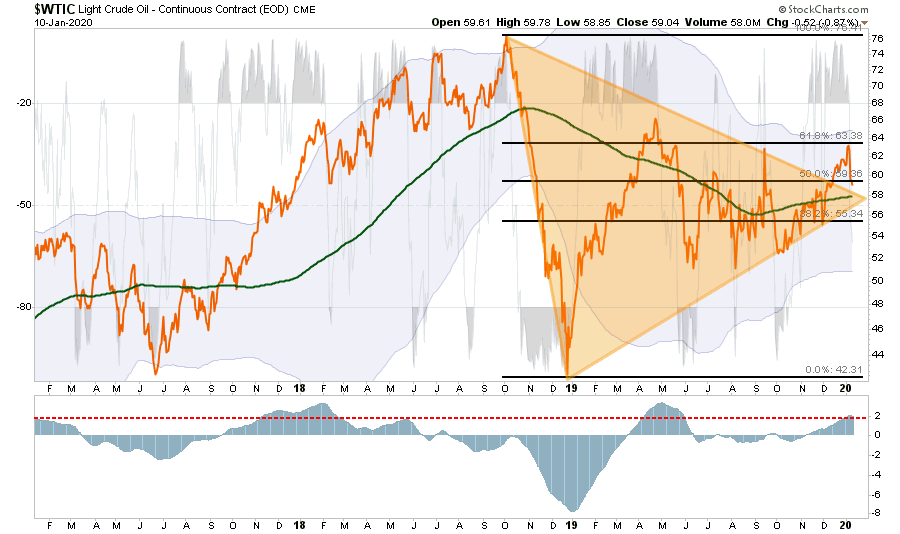
- Oil finally broke above the downtrend resistance line from the 2018 highs, which is bullish. However, the spurt from the “Iran spat,” shot oil prices to the 61.8% Fibonacci retracement level where it failed badly.
- With oil prices falling back below $60/bbl, it is imperative that oil maintains the 200-dma support level.
- As noted last week, with the short-term buy signal for oil is extended, the struggle we saw was not unexpected.
- Add positions on weakness that doesn’t violate the 200-dma
- Short-Term Positioning: Neutral
- Last Week: Hold positions.
- This Week: Hold positions
- Stop-loss for any existing positions is $58.
- Long-Term Positioning: Bearish
Gold
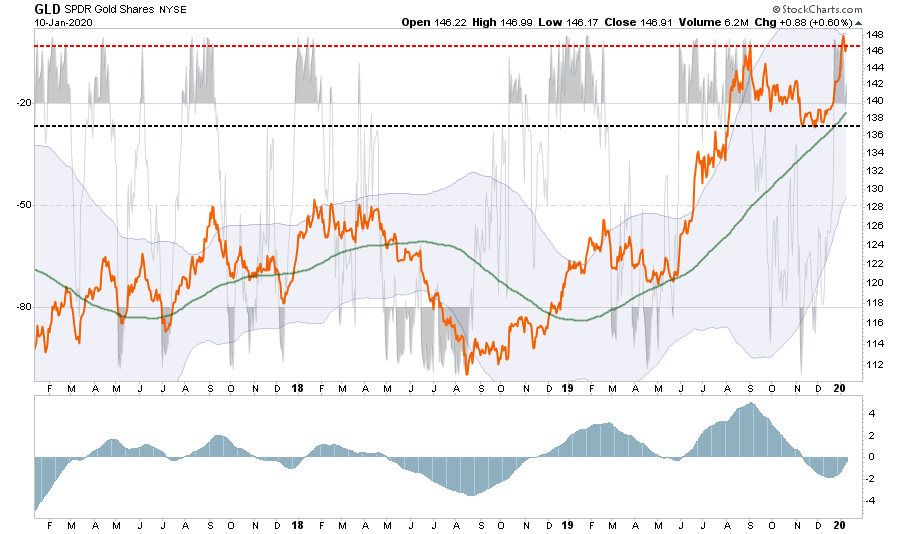
- Gold found its mojo last week, as Iran sparked fear in the markets. However, it faded a bit as tensions quickly dissapated.
- With gold now testing old highs, our positioning looks good particularly given that gold remains on a sell-signal currently. A reversal of the signal could suggest further highs to come.
- We used the recent weakness to add to our GDX and IAU positions taking them back to full weightings.
- Short-Term Positioning: Neutral
- Last week: Hold positions.
- This week: Hold positions
- Stop-loss for whole position adjusted to $137
- Long-Term Positioning: Neutral
Bonds (Inverse Of Interest Rates)
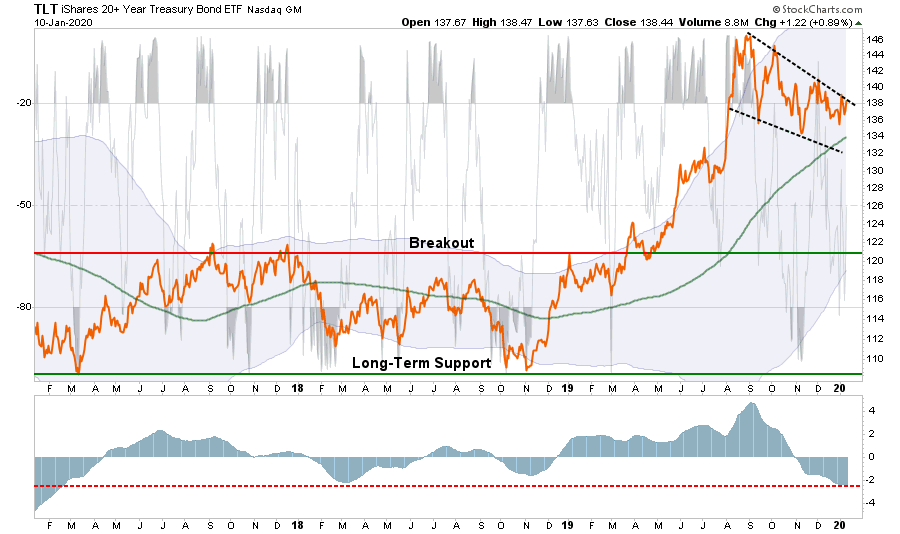
- Bond prices rallied last week, again, and are testing downtrend resistance. For now bonds remain in a bearish channel, suggesting higher yields are still likely short-term.
- I suspect we are going to get some economic turmoil sooner, rather than later, which will lead to a correction in the equity markets and an uptick in bond prices. The weak employment and wages report last Friday suggested such may be coming.
- Use lower bounds of the downtrend, and the 200-dma, to add to holdings currently.
- Short-Term Positioning: Bullish
- Last Week: Hold positions
- This Week: Hold positions
- Stop-loss is moved up to $132
- Long-Term Positioning: Bullish
U.S. Dollar
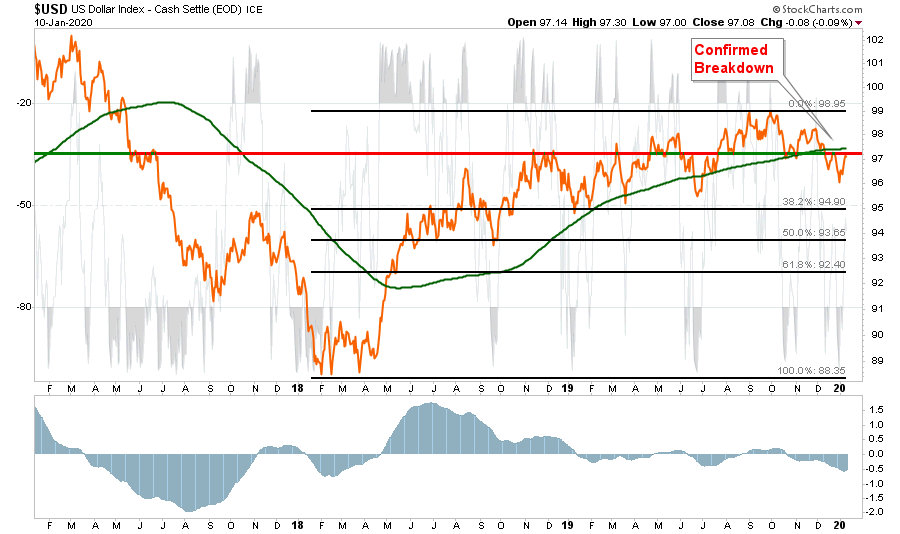
- Previously, we noted the dollar broke down below both the 200-dma and the bullish trend line. It then retested, and failed, at that previous support level which confirms a breakdown in the dollar from its previous bullish channel.
- Last week, the dollar has rallied back to that all important previous support line. IF the dollar can break back above that level, and hold, then commodities, and oil, will likely struggle.
- As stated last time: “It may be too early for a sharper dollar decline currently, as the U.S. economy is still the “cleanest shirt in the dirty laundry.”
- Be patient for now on commodity related exposures. Momentum still rules the market as a whole.
- The “sell” signal remains intact currently suggesting there is further downside, if it begins to reverse that will be an important clue.
Lance Roberts is a Chief Portfolio Strategist/Economist for RIA Advisors. He is also the host of “The Lance Roberts Podcast” and Chief Editor of the “Real Investment Advice” website and author of “Real Investment Daily” blog and “Real Investment Report“. Follow Lance on Facebook, Twitter, Linked-In and YouTube
Customer Relationship Summary (Form CRS)
Also Read



















